Arm Announces Neoverse V1 & N2 Infrastructure CPUs: +50% IPC, SVE Server Cores
by Andrei Frumusanu on September 22, 2020 9:00 AM EST- Posted in
- CPUs
- Arm
- Servers
- Infrastructure
- SVE
- Neoverse V1
- Neoverse N2
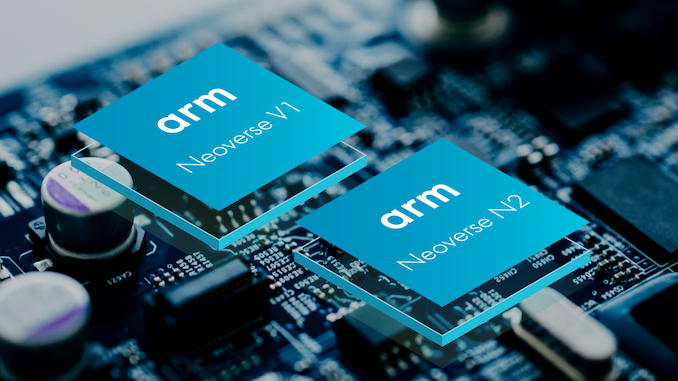
Arm’s ambitions for the server market has been a very long journey that’s taken years to materialise. After many doubts and false start attempts, today in 2020 nobody can deny that sever chips powered by the company’s CPU IP are not only competitive, but actually class-leading on several metrics.
Amazon’s Graviton2 64-core Neoverse N1 server chip is the first of what should become a wider range of designs that will be driving the Arm server ecosystem forward and actively assaulting the infrastructure CPU market share that’s currently dominated by the x86 players such as Intel and AMD.
The journey has been a long one, but has had its roots back in roadmaps publicly planned laid out by the company back in 2018. Fast-forward to 2020, not only have we seen products with the first-generation Neoverse N1 infrastructure CPU IP hit the market in commercial and publicly available form, but we’ve seen the company exceed their targeted 30% generational gain by a factor of 2x.
The Neoverse V1: A New Maximum Performance Tier Infrastructure CPU
Today, we’re ready to take the next step towards the next generation of the Neoverse platform, not only revealing the CPU microarchitecture previously known as Zeus, but a whole new product category that goes beyond the Neoverse N-series: Introducing the new Neoverse V-series and the Neoverse V1 (Zeus), as well as a new roadmap insertion in the form of the Neoverse N2 (Perseus).
The new Neoverse V1 introduces the new V-series into Arm’s infrastructure IP portfolio, and essentially this represents the company’s push for higher absolute performance, no matter the cost.
Earlier this spring we covered the company’s new mobile Cortex-X1 CPU IP which represented significant business model change for Arm: Instead of offering only a single one-fits-all CPU microarchitecture which licensees had to make due with in a wider range of designs and performance points, we’ve now seen a divergence of the microarchitectures, with one IP offering now focusing on pure maximum performance (Cortex-X1), no matter the area or power cost, while the other design (Cortex-A78) focuses on Arm’s more traditional maximised PPA (Power, Performance, Area) design philosophy.
The Zeus microarchitecture in the form of the Neoverse V1 is essentially the infrastructure counterpart to what Arm has achieved in the mobile IP offering with the Hera Cortex-X1 CPU IP: A focus on maximum performance, with a lesser regard to power and area.
This means that the V1 has significantly larger caches, cores structures, using up more area and power to achieve unprecedented performance levels.
In terms of generational performance uplift, it’s akin to Arm throwing down the gauntlet to the competition, achieving a ground-breaking +50 IPC boost compared to Neoverse N1 that we’re seeing in silicon today. The performance uplift potential here is tremendous, as this is merely a same-process ISO-frequency upgrade, and actual products based on the V1 will also in all likelihood also see additional performance gains thanks to increased frequencies through process node advancements.
If we take the conservatively clocked Graviton2 with its 2.5GHz N1 cores as a baseline, a theoretical 3GHz V1 chip would represent an 80% uplift in per-core single-threaded performance. Not only would such a performance uptick vastly exceed any current x86 competition in the server space in terms of per-core performance, it would be enough to match the current best high-performance desktop chips from AMD and Intel today (Though we have to remember it’ll compete against next-gen Zen3 Milan and Sapphire Rapids products).
Neoverse N2 is Perseus – Continues the PPA Focus
Alongside the Neoverse V1 platform, we’ve seen a roadmap insertion that previously wasn’t there. The Perseus design will become the Neoverse N2, and will be the effective product-positioning successor to the N1. This new CPU IP represents a 40% IPC uplift compared to the N1, however still maintains the same design philosophy of maximising performance within the lowest power and smallest area.
It can be a bit confusing when it comes to the microarchitectural generations that we’re talking about here, so I made a graph to illustrate what we could call generational siblings between Arm’s mobile, and server CPU IP:
Although this is just a general rough outline of Arm’s products, the important thing to note that there’s similarities between generations of Cortex and Neoverse products as they’ve being developed in tandem at similar moments in time during their design. The Neoverse N1 was developed in conjunction with the Cortex-A76, and thus the two microarchitectures can be regarded as sibling designs as they share a lot of similarities.
The Neoverse V1 can be regarded as a sibling design to the Cortex-X1, likely sharing a lot of the supersized core structures that had been developed for these two flagship CPUs.
The Neoverse N2 is a bit more special as it represents the sibling design to a next-generation Cortex-A core which is the follow-up to the A78. Arm says they’ll be licensing out this “Perseus” design by the end of the year and that customers already are engaging on beta RTL – we’re likely to hear more about this generation of products at next year’s TechDay event. The N2 would be lagging behind the V1 by one year and subsequently it'll take more time to see this in products.
As a note, all of the above designs are all based in Austin and can be regarded as in the same microarchitecture family that had been started off with the Cortex-A76. If I’m not mistaken, next-generation “Poseidon” designs will be on a fresh new microarchitecture started by Arm’s Sophia-Antipolis design team – although Arm does note that there’s a lot more collaboration and blur between the different teams nowadays. Here Arm already notes a +30% IPC uplift for this generation of designs, likely to hit products in 2023.
An Undisclosed Architecture with SVE: Armv9?
One very notable characteristic of both the Neoverse V1 and N2 are the fact that these now support SVE (Scalable Vector Extensions), with the V1 having two native 256-bit pipelines and the N2 being a 2x128-bit design. The advantage of SVE over other SIMD ISAs is the fact that code written in it can scale with the varying execution width of a microarchitecture, something that’s just not possible with today’s Neon or AVX SIMD instructions.
Fujitsu’s A64FX chip and custom core microarchitecture had been to date the only CPU announced and available with SVE, meaning the V1 and N2 will be Arm’s first own designs actually implementing SVE.
Today’s announcements around this part of the V1 and N2 CPUs raised more questions than it answered, as the company wasn’t willing to disclose whether this support referred to the first-generation SVE instruction set, or whether they already supported SVE2.
In fact, the company wouldn’t confirm even the base architecture of the designs, whether this were Armv8 designs or one of the subsequent iterations. This is extremely unusual for the company as it’s traditionally transparent on such basic aspects of their IPs.
What I think is happening here is that the V1 and N2 might be both Armv9 designs, and the company will be publicly revealing the new ISA iteration sometime between today’s announcement and mid next year at the latest – of course this is all just my own interpretation of the situation as Arm refused to comment on the topic.
Update: Actually it does seem that Arm had already publicly upstreamed the initial compiler entries to GCC for Zeus back in June, confirming that at least the Neoverse V1 is an Armv8.4+SVE(1) design. I still think the N2 might be a v9+SVE2 design.
At the end of the day, what we end up are two extremely compelling new microarchitectures that significantly push Arm’s positioning in the infrastructure market. The Neoverse N2 is an obvious design that focuses on Arm’s PPA metrics, and the company sees customers designing products that are primarily focused on “scale-out” workloads that requite a lot of CPU cores. Here we could see designs up to 128 cores.
The Neoverse V1 will see designs with lesser core-counts as the CPUs are just bigger and more power hungry. Arm sees the 64-96 range being what’s most likely to be adopted by licensees. These are the premier products that will be going against the best of what Intel and AMD have to offer- and if the performance projections pan out (as they usually do for Arm), then we’re in for a brutally competitive fight unlike we’ve seen before.
The first publicly known design confirmed to employ the new Neoverse V1 cores is SiPearl’s “Rhea” chip that looks to feature 72 cores in a 7nm TSMC process node. Ampere’s “Siryn” design would also be a candidate for applying the V1 microarchitecture, targeted for a 2022 release on TSMC’s 5nm node.
Today’s announcement has been more of a teaser or unveiling, with the company planning to go into more details about the architecture and microarchitectures of the designs at a later date. Arm's DevSummit is scheduled for October 6-8th - and might be where we'll hear a bit more about the new architecture.
Related Reading:
- Arm Announces Neoverse N1 & E1 Platforms & CPUs: Enabling A Huge Jump In Infrastructure Performance
- Arm's New Cortex-A78 and Cortex-X1 Microarchitectures: An Efficiency and Performance Divergence
- Amazon's Arm-based Graviton2 Against AMD and Intel: Comparing Cloud Compute
- Next Generation Arm Server: Ampere’s Altra 80-core N1 SoC for Hyperscalers against Rome and Xeon
- Arm Announces Neoverse Infrastructure IP Branding & Future Roadmap


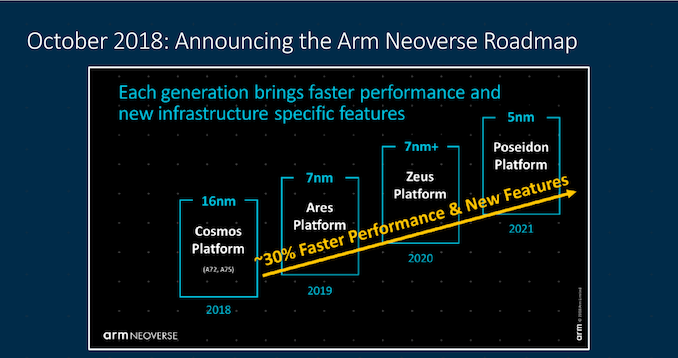
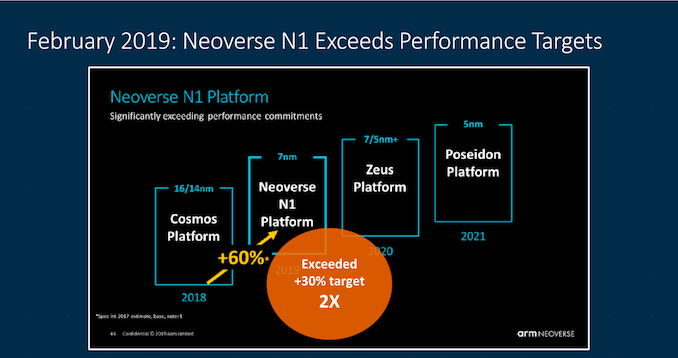
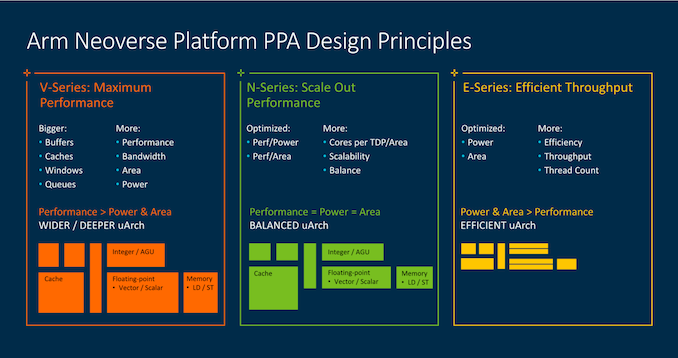
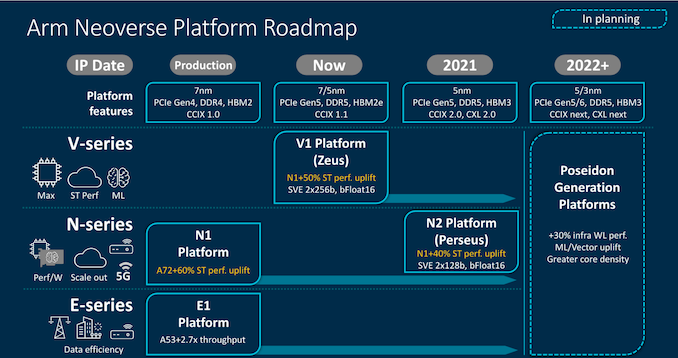
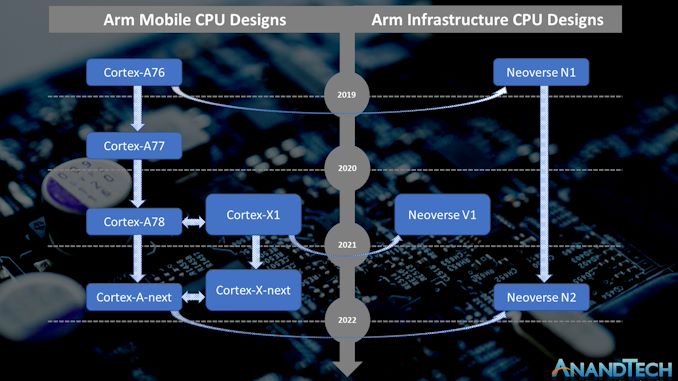
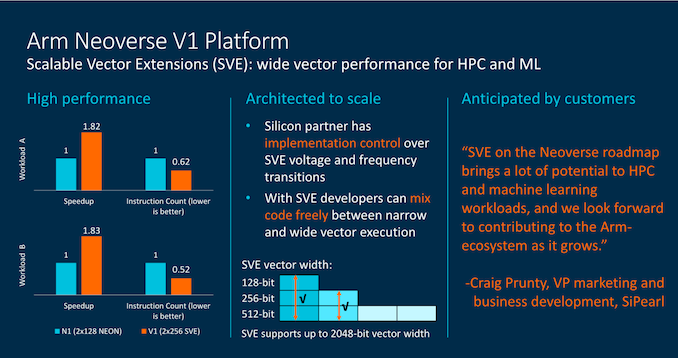
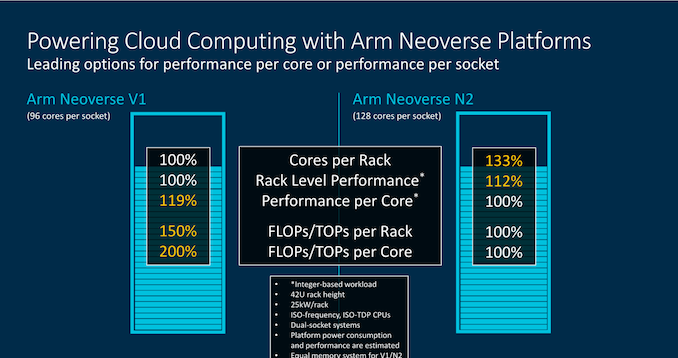
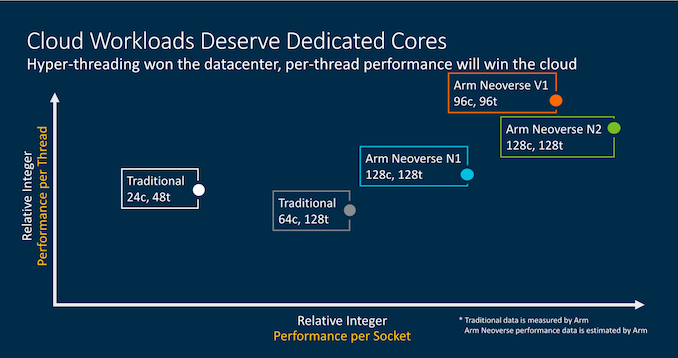








74 Comments
View All Comments
mkanada - Tuesday, September 22, 2020 - link
Thats really good news. I hope, in 1-2 years, be able to buy a ARM desktop with similar performance found in x86 high end CPUs. With NVidia, shortly we will find ARM platform with high end GPU.The best scenario would be if a V-Series CPU (more cache, deep pipelines, etc) could be 'reconfigured' in a E-Series CPU by software. Thats sounds crazy, but the reality is that some problems are best suited to a high frequency CPU (V-Series). Other problems are best suited to a high thread count (many E-Series CPUs). Sounds too crazy?
Vitor - Wednesday, September 23, 2020 - link
Well, as soon as Apple decides to make CPU with a 65W TDP, especially in 3nm, x86 will fade away even for deskops.mkanada - Tuesday, September 22, 2020 - link
Other question is about memory caches. With 2.5D and/or 3D chips, where memory is near or at the top of the CPU, how many cache/buffer/etc we really need? The silicon area that is used to huge caches, could it be used to more execution cores?webdoctors - Wednesday, September 23, 2020 - link
Pretty skeptical, x86 is pretty firmly entrenched.AMD tried to do custom ARM servers a few years ago and it died. Not sure what's changed...
ChrisGX - Tuesday, September 29, 2020 - link
That is an unexpected response in view of the content of the article that sought to set out what has (supposedly) changed. Certainly, there is no obligation on anyone to prejudge this matter but if things go as ARM suggests the "not sure what's changed" line won't carry any weight. So, we have a claim regarding new levels of performance that can't be confirmed at this point but the truth or falsehood of that claim will be easy to judge soon enough. Andrei is right, though. If ARM's performance claims are borne out (without energy efficiency taking a hit), there will be a world of trouble in store for Intel and AMD. Performance and energy efficiency are understandably the key criteria by which to judge the viability of different processor designs. When you do well on both fronts you are doing very well indeed.sing_electric - Wednesday, September 23, 2020 - link
If Nvidia's purchase of ARM goes through, it's very likely that Nvidia can become Intel before Intel becomes Nvidia... Kind of a scary situation where Nvidia would control the dominant chip platform by volume (let's be honest, way more phones sold than PCs), on top of its significant lead in GPU/AI perf.GeoffreyA - Wednesday, September 23, 2020 - link
I suppose what happens will all depend on Windows, which already has Arm builds and, from what I read, can run 32-bit x86 applications by emulation (not x64 yet, but I'm sure they could add that). A time may come, and Intel and AMD may have to abandon x86 and start implementing the Arm instruction set for their main CPUs. Quite likely, considering their skill in semiconductor, those will end up being among the best Arm processors (cf. Apple right now).For my part, being old-school, I hope x86 wins the day and goes on running, but with all these forces pushing Arm, it seems hopeless, like many other things this world has lost, in the name of "progress."
Perhaps, at the end of the day, it won't really matter; we'd still be able to choose Windows and Intel or AMD (or whatever CPU), and everything will work just like it's always done (for the most part).
GeoffreyA - Wednesday, September 23, 2020 - link
Realised it's because of Wow64 that Windows on Arm only supports 32-bit x86.Thala - Thursday, September 24, 2020 - link
Windows ARM already has a dual WoW layer for both 32 bit ARM and x86. They can just add a third for 64bit x86.nemi2 - Thursday, September 24, 2020 - link
The GPU could be ARMs trojan horse. Put 16 ARM cores on a 50xx card and enable the developers to run local code. At some point most of the render engine could be executing on the GPU. Linux could be running full time on it.